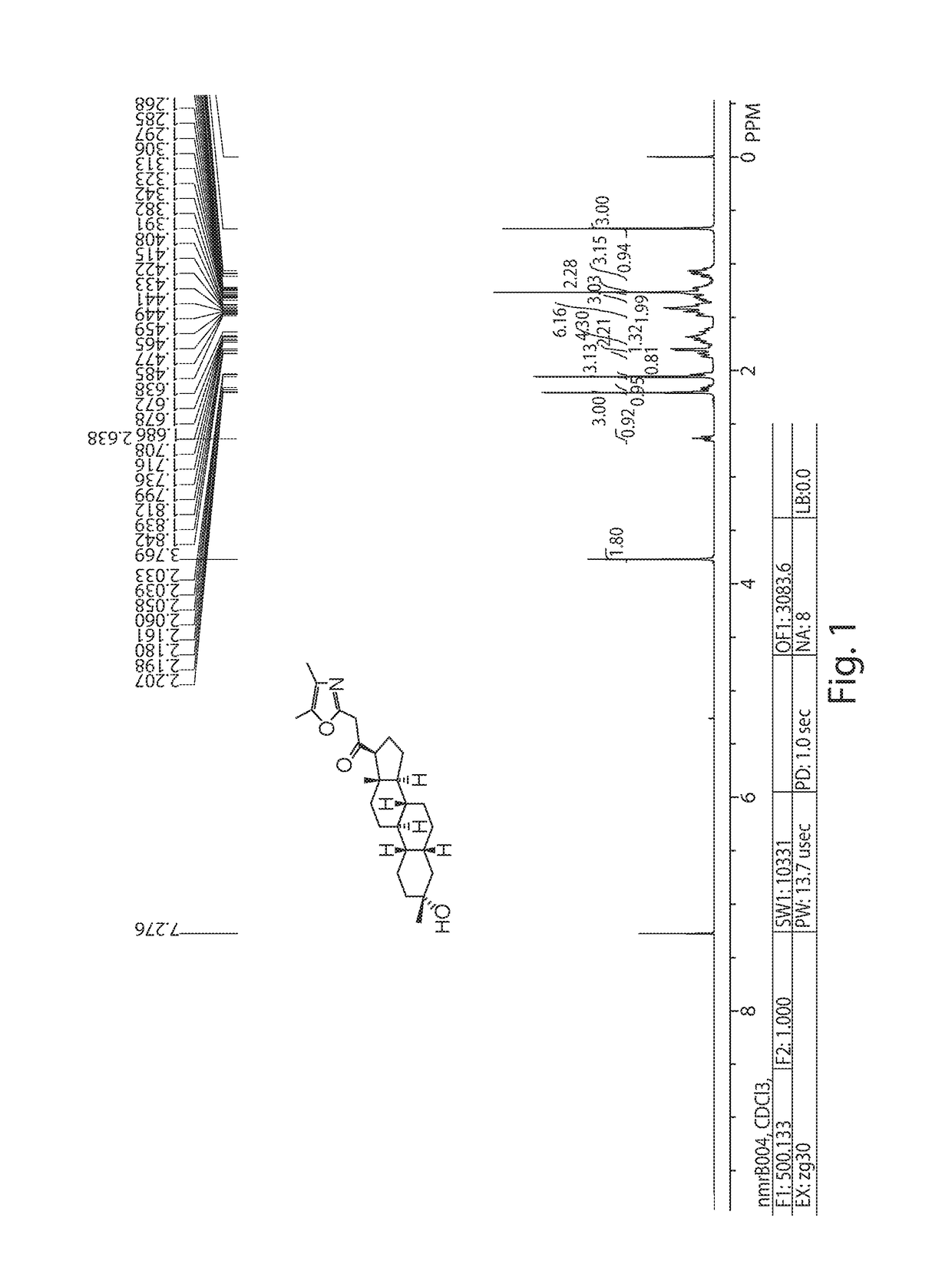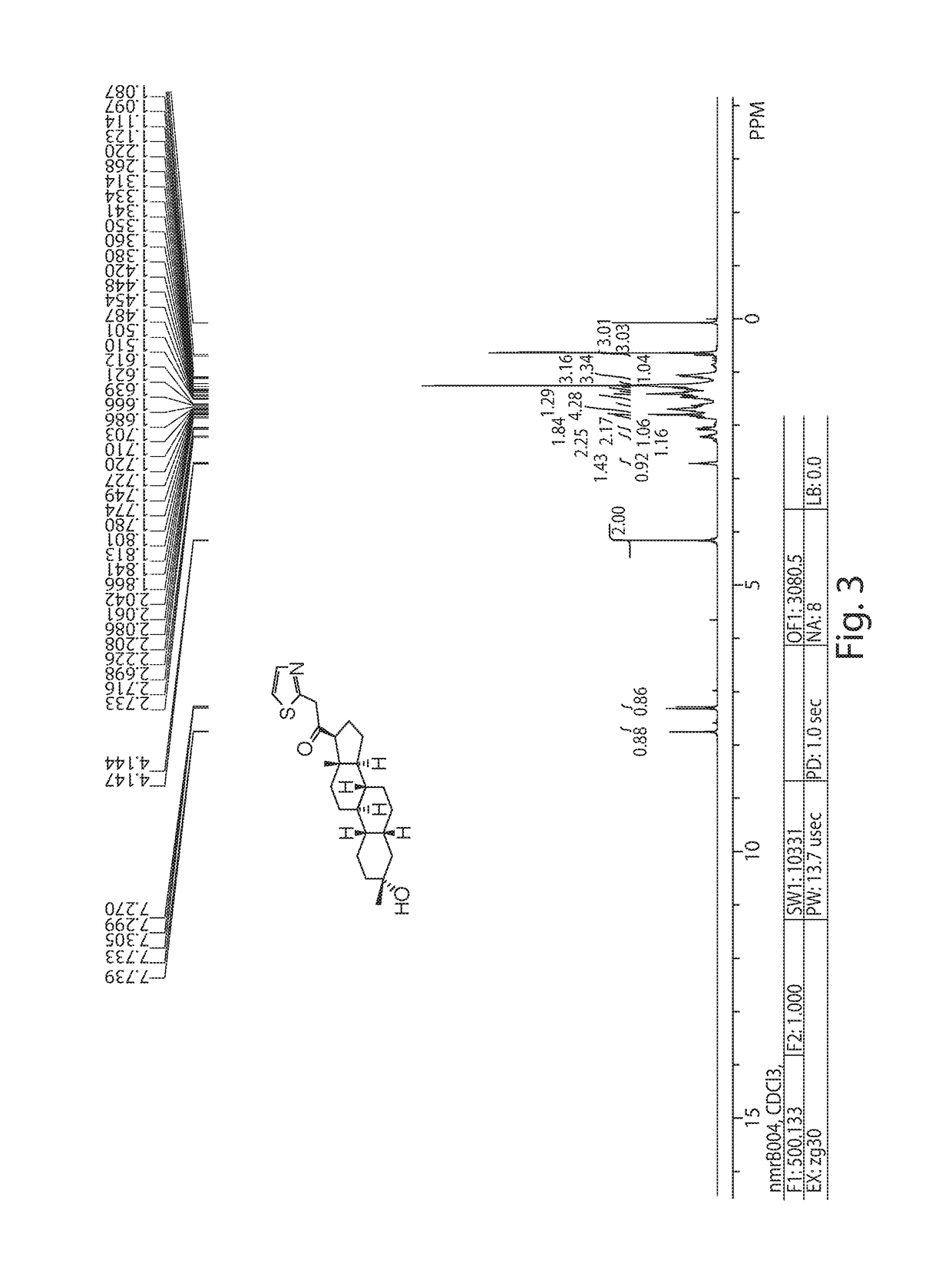19-nor C3, 3-disubstituted C21-C-bound heteroaryl steroids and methods of use thereof
a heteroaryl steroid and c21-c-bound technology, applied in the field of 19-nor c3, 3disubstituted c21-c-bound heteroaryl steroid, can solve the problems that progesterone is not consistently effective in the treatment of the aforementioned syndromes, and achieve the effects of preventing further metabolism, reducing the potential for oxidation of the hydroxy moiety, and reducing the risk of side effects
- Summary
- Abstract
- Description
- Claims
- Application Information
AI Technical Summary
Benefits of technology
Problems solved by technology
Method used
Image
Examples
example 1
Synthesis of Compound SA-J
[0285]
[0286]Synthesis of compound SA-B. Compound SA-A (500 mg, 1.84 mmol) and 10% Pd / black (20 mg) in tetrahydrofuran (5 mL) and concentrated hydrobromic acid (0.02 mL) was hydrogenated with a hydrogen balloon at 1 atm. After stirring at room temperature for 24 h, the mixture was filtered through a pad of celite and the filtrate was concentrated in vacuo. Recrystallization from acetone to give compound SA-B (367 mg, 1.34 mmol, 73%). 1H NMR (400 MHz, CDCl3), δ (ppm) 2.61 (t, 1H), 2.5 (dd, 1H), 2.2 (m, 4H), 2.1 (m, 2H), 1.9 (m, 1H), 1.85 (m, 2H), 1.75 (1H), 1.65 (m, 3H), 1.55 (m, 2H), 1.45-1.1 (m, 6H), 0.98 (s, 3H).
[0287]Synthesis of compound SA-C. To a solution of compound SA-B (274 mg. 1 mmol) in methanol (4 mL) was added iodine (0.1 mmol). After stirring at 60° C. for 12 h, TLC showed no SM and the solvent was removed in vacuo. The crude product was dissolved in dichloromethane (20 mL) and washed with saturated NaHCO3 (15 mL), brine, dried over Na2SO4, fil...
example 2
Synthesis of Compound SA-1
[0295]
[0296]To a stirred solution of 2,4,5-trimethyloxazole (153 mg, 1.375 mmol) in 10 mL of THF was added LDA (2 M; 0.688 ml, 1.375 mmol) at −78° C. After stirring at −78° C. for 30 min, a solution of SA-J (0.1 g, 0.275 mmol) in 5 mL of THF was added dropwise at −78° C. After stirring at −78° C. for 1 h, the reaction mixture was poured into ice-cold water and extracted with EtOAc (100 mL×3), washed with brine (100 mL×3), dried(MgSO4), filtered, and evaporated in vacuo, then purified by prep-HPLC to afford SA-1 as the white solid 33 mg, 29% yield. 1H NMR (400 MHz, CDCl3), δ (ppm), 3.76 (s, 2H), 2.68 (1H,), 2.20 (s and t, 4H), 2.03 (s and m, 4H), 1.75 (m, 3H), 1.65 (m, 4H), 1.15-1.5 (3×m and s, 15H), 1.1 (m, 3H), 0.75 (s, 3H). LC-MS: rt=7.2 min, m / z=414.2 [M+H]+.
example 3
Synthesis of Compound SA-2
[0297]
[0298]To a stirred solution of 2-methylpyridine (128 mg, 1.375 mmol) in 10 mL of THF was added nBuLi (2.5 M; 0.55 ml, 1.375 mmol) at rt. After stirring at rt for 30 min, a solution of SA-J (0.1 g, 0.275 mmol) in 5 mL of THF was added dropwise at rt. After stirring at rt for 15 h, the reaction mixture was poured into ice-cold water and extracted with EtOAc (100 mL×3), washed with brine (100 mL×3), dried (MgSO4), filtered, and evaporated in vacuo, then purified by prep-HPLC to afford SA-2 as the yellow solid 8 mg, 7% yield. 1H NMR (500 MHz, CDCl3), δ (ppm), 8.54 (d, 1H), 7.64 (t, 1H), 7.20 (d, 1H), 7.16 (dd, 1H), 3.9 (AB m, 2H), 2.72 (t, 1H), 2.1 (bd and q, 2H), 1.75 (m, 7H), 1.6-1.9 (m, 4H), 1.45 (m, 7H), 1.26 (m and s, 7H), 1.1 (m, 3H), 0.67 (s, 3H). LCMS: Rt=2.355 min, MS (ESI) m / z: 396 [M+H]+.
PUM
 Login to View More
Login to View More Abstract
Description
Claims
Application Information
 Login to View More
Login to View More - R&D
- Intellectual Property
- Life Sciences
- Materials
- Tech Scout
- Unparalleled Data Quality
- Higher Quality Content
- 60% Fewer Hallucinations
Browse by: Latest US Patents, China's latest patents, Technical Efficacy Thesaurus, Application Domain, Technology Topic, Popular Technical Reports.
© 2025 PatSnap. All rights reserved.Legal|Privacy policy|Modern Slavery Act Transparency Statement|Sitemap|About US| Contact US: help@patsnap.com



